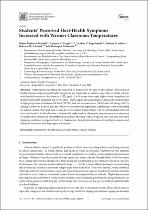 ResearchSpace
ResearchSpace
Students’ perceived heat-health symptoms increased with warmer classroom temperatures
JavaScript is disabled for your browser. Some features of this site may not work without it.
- ResearchSpace
- →
- Research Publications/Outputs
- →
- Journal Articles
- →
- View Item
| dc.contributor.author |
Bidassey-Manilal, S

|
|
| dc.contributor.author |
Wright, CY

|
|
| dc.contributor.author |
Engelbrecht, JC

|
|
| dc.contributor.author |
Albers, PN

|
|
| dc.contributor.author |
Garland, Rebecca M

|
|
| dc.contributor.author |
Matooane, A

|
|
| dc.date.accessioned | 2016-07-20T11:09:24Z | |
| dc.date.available | 2016-07-20T11:09:24Z | |
| dc.date.issued | 2016 | |
| dc.identifier.citation | Bidassey-Manilal, S., Wright, C.Y. Engelbrecht, J.C., Albers, P.N., Garland, R.M. and Matooane, M. 2016. Students’ perceived heat-health symptoms increased with warmer classroom temperatures. International Journal of Environmental Research and Public Health, vol. 13(6) | en_US |
| dc.identifier.issn | 1660-4601 | |
| dc.identifier.uri | http://www.mdpi.com/1660-4601/13/6/566 | |
| dc.identifier.uri | http://hdl.handle.net/10204/8672 | |
| dc.description | Copyright: 2016 MDPI. | en_US |
| dc.description.abstract | Temperatures in Africa are expected to increase by the end of the century. Heat-related health impacts and perceived health symptoms are potentially a problem, especially in public schools with limited resources. Students (n = 252) aged ~14–18 years from eight high schools completed an hourly heat-health symptom log over 5 days. Data loggers measured indoor classroom temperatures. A high proportion of students felt tired (97.2%), had low concentration (96.8%) and felt sleepy (94.1%) during at least one hour on any day. There were statistically significant correlations, when controlling for school cluster effect and time of day, between indoor temperatures ¥32 C and students who felt tired and found it hard to breathe. Consistently higher indoor classroom temperatures were observed in classrooms constructed of prefabricated asbestos sheeting with corrugated iron roof and converted shipping container compared to brick classrooms. Longitudinal studies in multiple seasons and different classroom building types are needed. | en_US |
| dc.language.iso | en | en_US |
| dc.publisher | MDPI | en_US |
| dc.relation.ispartofseries | Workflow;17214 | |
| dc.subject | Climate change | en_US |
| dc.subject | Heat-health symptoms | en_US |
| dc.subject | Warm classroom temperatures | en_US |
| dc.title | Students’ perceived heat-health symptoms increased with warmer classroom temperatures | en_US |
| dc.type | Article | en_US |
| dc.identifier.apacitation | Bidassey-Manilal, S., Wright, C., Engelbrecht, J., Albers, P., Garland, R. M., & Matooane, A. (2016). Students’ perceived heat-health symptoms increased with warmer classroom temperatures. http://hdl.handle.net/10204/8672 | en_ZA |
| dc.identifier.chicagocitation | Bidassey-Manilal, S, CY Wright, JC Engelbrecht, PN Albers, Rebecca M Garland, and A Matooane "Students’ perceived heat-health symptoms increased with warmer classroom temperatures." (2016) http://hdl.handle.net/10204/8672 | en_ZA |
| dc.identifier.vancouvercitation | Bidassey-Manilal S, Wright C, Engelbrecht J, Albers P, Garland RM, Matooane A. Students’ perceived heat-health symptoms increased with warmer classroom temperatures. 2016; http://hdl.handle.net/10204/8672. | en_ZA |
| dc.identifier.ris | TY - Article AU - Bidassey-Manilal, S AU - Wright, CY AU - Engelbrecht, JC AU - Albers, PN AU - Garland, Rebecca M AU - Matooane, A AB - Temperatures in Africa are expected to increase by the end of the century. Heat-related health impacts and perceived health symptoms are potentially a problem, especially in public schools with limited resources. Students (n = 252) aged ~14–18 years from eight high schools completed an hourly heat-health symptom log over 5 days. Data loggers measured indoor classroom temperatures. A high proportion of students felt tired (97.2%), had low concentration (96.8%) and felt sleepy (94.1%) during at least one hour on any day. There were statistically significant correlations, when controlling for school cluster effect and time of day, between indoor temperatures ¥32 C and students who felt tired and found it hard to breathe. Consistently higher indoor classroom temperatures were observed in classrooms constructed of prefabricated asbestos sheeting with corrugated iron roof and converted shipping container compared to brick classrooms. Longitudinal studies in multiple seasons and different classroom building types are needed. DA - 2016 DB - ResearchSpace DP - CSIR KW - Climate change KW - Heat-health symptoms KW - Warm classroom temperatures LK - https://researchspace.csir.co.za PY - 2016 SM - 1660-4601 T1 - Students’ perceived heat-health symptoms increased with warmer classroom temperatures TI - Students’ perceived heat-health symptoms increased with warmer classroom temperatures UR - http://hdl.handle.net/10204/8672 ER - | en_ZA |





